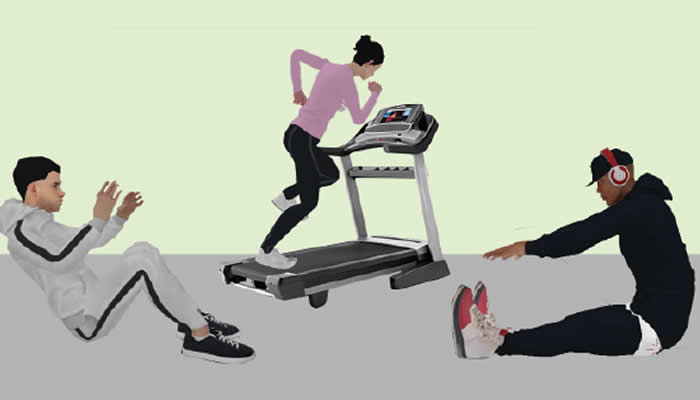
Exercise is medicine, the same way food is medicine, says a professor of Exercise Physiology at the Lagos State University, Ojo, Lagos State, Oluwole Akeredolu.
The don adds that engaging in regular and intentional exercise can tackle several health problems.
The World Health Organisation states that one in four adults does not meet the global recommended levels of physical activity. It adds that regular physical activity, such as walking, cycling, wheeling, doing sports or active recreation, provides significant benefits for health, stating that people who are insufficiently active have a 20 to 30 per cent increased risk of death compared to those who are sufficiently active.
But exercise is not something done at the snap of a finger or when the mood calls for it. Several factors must be checked to determine the type of exercise to be done, the intensity, the time of the day and the minutes to be spent vis-a-vis, and the individual’s health status.
Akeredolu advises that a medical checkup should be done at the start of exercise to check for health issues that must be taken care of.
The expert advises beginners to start gradually and determine the extent of exercise and the time it would be done.
“In starting to exercise, you have to think of many things as, what am I exercising for? Is it because I have a disease or because I want to make it my normal lifestyle? There are many exercises to engage in because the body is made of many parts. There are exercises for the arm, trunk, leg, neck, head, it depends on what you want to exercise,” Akeredolu says.
Also, a professor of Physiotherapy at Bayero University, Kano, Kano State, Ganiyu Sokunbi, states that exercise is needed to be in a complete state of physical, mental and social wellbeing.
Sokunbi adds, “For example, exercise is needed to control weight, prevent certain health conditions and diseases, improve mood, promote better sleep, put the spark back into one’s sexual life and many other benefits of exercise. To be in a perfect state of health, one needs to carry out exercises as recommended by WHO.”
Below are some recommended daily physical activities to engage in.
Walking
Several statistics have reported a global increase in sedentary lifestyles. The effects in the long run can cause obesity, type two diabetes, and cardiovascular diseases among others.
Akeredolu advises, “No matter your age and status, walk around your home for an hour every day or take about 10,000 steps in a day. If you can’t walk, you can ride a bicycle, if you can’t ride a bicycle, you can jog, move around, run on a spot, do some push-ups and jump up.”
The don further cautions against sitting for long hours while at the workplace. He advises that individuals take little walks around the office, and make use of the stairs after sitting for a long time to prevent the effects of a sedentary lifestyle.
“I know of some offices where they call such a health break for about 25 to 30 minutes. They have time for it and everyone would stand from their seat to walk around and return to their seat. Music would be playing in the background and those who want to dance would do so. Sometimes in conferences, health breaks are organised as well, little exercise such as standing for some time, lifting the hands, legs or stretching, this is to prevent sitting down for long,” he adds.
He adds that this exercise would help the heart to be healthy.
Sokunbi also advises brisk walking, which involves walking faster than the normal walk steps of an individual.
Swimming
The use of one’s entire body to move through the water is an apt physical activity that helps to build endurance, take off stress, tone muscles and build strength among others.
Akeredolu explains, “What happens when you are swimming is that you hold your breath while under the water, this will help your heart and lungs. The use of your arms and legs while swimming also helps to strengthen them.” It is also advisable that those unskilled in the art of swimming should avoid diving into the pool without training or presence of a trainer.
Reduce sitting time
Sokunbi states that there was a need to reduce the time spent in sedentary positions such as sitting and lying down. He adds that such activities are inimical to perfect health.
“For those who cannot engage in a daily moderate physical activity for a minimum of 30 minutes in one attempt, they can break it into five minutes daily and consistently build it into their life pattern and still achieve the same benefit. Eventually, they can increase the time from five to 10, 15 minutes and then achieve the 30 minutes daily recommendation,” he states.
Riding bicycle
A 2019 review suggests that cycling reduces the risk of cardiovascular diseases and increases cardiovascular fitness.
Cycling improves the function of the lower body, strengthens the leg muscles, builds up muscular endurance, decreases stress levels, improves posture and coordination and limits body fat levels among others.
Sokunbi notes that there are two types of bicycle, the mobile ones seen on the streets and the stationary ones that remain in a spot while riding is being done. He recommends biking for a minimum of 30 minutes regularly.
Treadmill
The treadmill is exercise equipment that helps you to walk, jog or run at varying speeds. This provides a straightforward and efficient aerobic workout and it helps to keep fit, burn calories and lose weight. Treadmill walking is recommended for 30 minutes daily.
Running
Sokunbi states that running falls under vigorous intensity exercise. It helps to build strong bones, strengthen muscles, improve cardiovascular fitness and maintain a healthy weight. Running is however not advisable to be done daily. This is because the exercise is vigorous and continuously engaging in it can lead to sore muscles, stress and prolonged fatigue.
Dancing
“If it becomes regular and has become a part of one’s lifestyle, it is useful to maintain a state of health,” Sokunbi states.
A wellness blog states that dancing involves several movements such as jumping, hopping, shaking, shuffling and shimmying. However, this is an intense workout that burns out calories and can get the heart rate up. Dancing helps to boost mood and fitness levels.
There are several dance moves and exercises that are appropriate for different ages and health statuses of people. This further reiterates the importance of knowing one’s health status.
It is advisable to start with aerobics dancing such as ballet, jazz and Zumba among others because they are classified as low-impact workouts which are slow-paced compared to others.
Resistance training
Sokunbi notes that resistance training helps to develop muscle strength in different parts of the body. It also helps to improve focus and cognitive function, reduce anxiety and depressive symptoms and develop feelings of wellbeing. Squats, lunges, deadlifts, chin ups/pull ups, lat pulldown, bench presses and push ups are examples of resistance training.
Before the start of the exercises, warm-ups with light aerobic exercises are important. Also, since the goal is to keep healthy, the rush to achieve a particular size should be non-existent.





